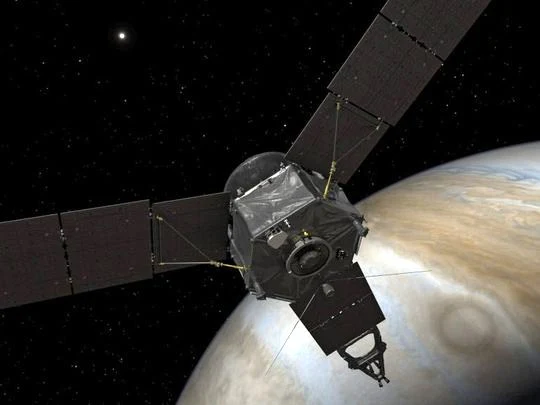"We just did the hardest thing NASA's ever done," said participant Scott Bolton, as the spacecraft Juno confirmed that after a five year journey it had successfully gone into orbit around Jupiter.
The space age commenced with Sputnik, often described as about the size of a basketball. Juno is a sophisticated, heavy shielded research vehicle that is the size of a basketball court.
Jupiter is in one of the most dangerous places in the solar system, due in part to the heavy radiation of this massive world. Jupiter is also the first planet in the solar system to be formed, and so Juno's observations may shed light on obscure cosmic history.
In addition to all the scientific instruments, there is a camera, the JunoCam, that is reserved for public use. As this New Yorker article notes: "Freed from the burden of scientific responsibility, amateurs and enthusiasts will be able to vote online to determine where JunoCam points and which features it captures. “It will provide the very first views of Jupiter’s poles, and the most incredible close-up views of the planet ever seen,” Bolton said. “I expect we will probably discover some new moons, too. But it’s really a public camera.” Already, JunoCam’s discussion boards are alight: six-year-old Bee wants more photos of the red spot, while Hogarth-11 is voting for a closer look at greenish dots near Jupiter’s equator."
Update: Washington Post expands on the science to come during this mission, and adds this about Jupiter: "Jupiter is so massive that it's heftier than everything else in the solar system (except for the sun) put together. More than 1,000 Earths could fit inside it. It's a mystery wrapped in an enigma — both its raging surface storms, which include the Great Red Spot, and its hidden core remain largely unknown to science — and learning more about the strange planet could help us understand the building blocks of life on our own planet and beyond."
NASA also extended the working lives of 9 ongoing spacecraft missions. As Carl Sagan pointed out in the final episode of Cosmos--which by coincidence I watched again tonight, in its digital restoration--it was by studying other planets that scientists here discovered the ozone layer (recently showing signs of healing, thanks to efforts begun decades ago) and the likely phenomenon of nuclear winter. Even earlier, James Lovelock began formulating his Gaia theory based on studies of Mars.
Recent observations by the Curiosity Rover suggest more strongly that Mars was once much like the Earth, with an atmosphere and watery oceans. What went wrong? Venus is another cautionary tale, for it seems to be a lifeless victim of runaway greenhouse heating. These planetary neighbors are reminders of how fragile is our purchase on this planet, with its wisp of an atmosphere as our life-giving protection.
Sagan remains a touchstone for the ethics of space exploration. For him (unlike, say, the makers of the film Interstellar) it's not an either/or proposition. Space exploration and care of the Earth must coexist, and the Earth always comes first.
The New Yorker article notes that several other space missions came to fruition on July 4. This July 4 also happens to coincide with Earth's Aphelion, or the farthest point from the sun it reaches in its orbit. (As this piece points out, that distance has a lot less to do with our surface temperature than the planet's tilt that determines the seasons, but it is thought to be related to periodical Ice Ages.)















No comments:
Post a Comment